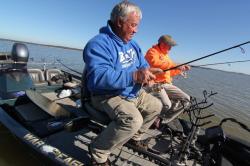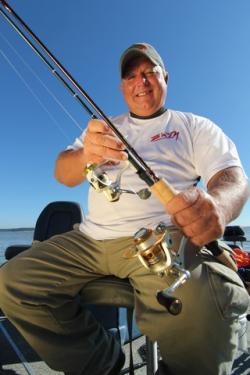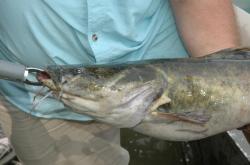January bass fishing can be good, but it is often not consistent. Two club tournaments and a trip to Lanier proved this point during the past few weeks. Some people catch fish and some don’t this time of year, but that is true at any time of year.
Ryan Coleman and I fished Lanier last Sunday. The weather the week before had been so nice we had planned to fish all day, but the rain and cold wind made us quit after only a little over four hours on the lake. We started just before 9:00 AM and headed in when the rain got hard a little after 1:00 PM.
Ryan caught four spotted bass, two of them over the 14 inch size limit, and I had one 13 inch spot during that time. On light tackle, those bass really put up a fight. Spots seem to fight twice as hard as largemouth, and in cold water they really let you know they do not like being hooked!
Our trip was for a February Georgia Outdoor News article. Ryan grew up in Griffin and lived here until a few years ago. He now lives within two miles of Lanier and fishes it often. We fished main lake points for spotted bass since the cold air had made the largemouth we had planned on catching head for deeper water.
Ryan caught his fish on a Texas rigged 5 inch Finesse worm and mine hit a 1/4 ounce jig and pig. All the bass were near the 30 foot depth level and fought hard. They were fun to catch, and the one I landed was my first bass this year!
If you go to Lanier, try little worms and jigs in about 30 feet of water on main lake and creek points. Rocks and brush help, and the bigger fish usually stay tight to the cover. Shake your bait when you hit the brush to make them bite.
Potato Creek Bassmasters fished their first tournament of the year last Saturday, and Bruce Odom started it out right by winning with two bass weighing 2.68 pounds. He also had big fish with a 1.78 pound bass. Twenty three members fished at Jackson for 9 hours to catch 12 keeper bass.
In that tournament, Lee Hancock placed second with two keepers, Donnie Willis was third and Chris Corley finished fourth. Ten of the 23 fishermen landed a bass big enough to bring to the scales on that cold, clear, windy day.
Members of the Flint River Bass Club did not fare as well on the weather for the first tournament of the year. Held two weeks ago today, the pouring rain kept all but six members at home. Bruce Willis had a good day, catching three bass weighing about six pounds to win. Three other members caught a bass or two, and two other members did not catch a keeper, if my information is correct.
George Hamby fished with Bruce and said they caught their bass in shallow water in a 30 minute span about an hour before the tournament was over. They fished hard all day, and really worked that pattern after catching four bass fast, but did not catch any more. Fishing is really hit or miss this time of year. If you are in the right place, you hit. Otherwise you get lots of casting practice.
The Spalding County Sportsman Club is holding its first tournament of the year today, at West Point. Hope we have good luck and nice weather, but that is always a gamble this time of year. Being in a club does make you go fishing even when the weather is not perfect, and sometimes I need that little nudge in January.
All three clubs in Griffin have tournaments scheduled in February. Visit one and consider joining. You can meet lots of nice people and maybe learn something about bass fishing. Or you may teach us about it. Come on out and join us for fun, fellowship and fishing!
Get out on the water and go fishing. You might catch some bass, or you might just cast a lot. Either way, it is better than sitting at home wishing you were fishing!







